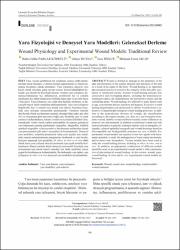| dc.contributor.author | Parlar Köprülü, Rabia Edibe | |
| dc.contributor.author | Mutlu, Gökçe | |
| dc.contributor.author | İpekçi, Esra | |
| dc.contributor.author | Okur, Mehmet Evren | |
| dc.date.accessioned | 2022-11-09T08:35:19Z | |
| dc.date.available | 2022-11-09T08:35:19Z | |
| dc.date.issued | 2022 | en_US |
| dc.identifier.citation | Parlar Köprülü, R. E., Mutlu, G., İpekçi, E. ve Okur, M. E. (2022). Yara fizyolojisi ve deneysel yara modelleri: Geleneksel derleme. Literatür Eczacılık Bilimleri Dergisi, 11(2), 94-103. http://doi.org/10.5336/pharmsci.2022-88482 | en_US |
| dc.identifier.issn | 2022-88482 | |
| dc.identifier.uri | http://doi.org/10.5336/pharmsci.2022-88482 | |
| dc.identifier.uri | https://hdl.handle.net/20.500.12511/9946 | |
| dc.description.abstract | Yara, vücuda gelebilecek bir yaralanma sonucu cildin epidermisinde hasar oluşması ve derinin normal anatomisinin ve fonksiyonlarının bozulması olarak tanımlanır. Yara iyileşmesi, kazayla veya kasıtlı olarak meydana gelen travma sonrası derinin bütünlüğünü korumak için önemli bir fizyolojik süreçtir. Normal yara iyileşmesi, hemostaz/inflamatuar faz, inflamasyon, proliferatif faz ve yeniden şekillenme fazı dâhil olmak üzere birbirini takip eden ve üst üste binen 4 fazı içerir. Yara iyileşmesi; yaş, eşlik eden hastalık, beslenme ve hijyen gibi birçok faktör tarafından etkilenmektedir. Aşırı yara iyileşmesi (hipertrofik skar ve keloid) veya kronik yara (ülser), bozulmuş fizyolojik yara iyileşme süreçlerinin göstergesidir. Yaraların temelde akut/kronik olarak ayrılmasının yanında, oluştuğu bölge (ağız, göz, deri vb.) ve oluşumuna göre (travmaya bağlı yara, diyabetik yara ve yanık yaraları) sınıflandırılması, bakımı ve tedavisi açısından farklılıklar oluşturmaktadır. Genel olarak topikal antiseptikler ile yapılan geleneksel yara bakımının yanında günümüzde otogreftler, allogreftler, kültürlü epitelyal otogreftler ve biyouyumlu ve biyobozunur polimerlere dayalı yara pansumanları gibi tedavi seçenekleri de bulunmaktadır. Deneysel yara modelleri, terapötik potansiyele sahip yeni ajanları test etmek, doku onarım mekanizmasının patogenezini incelemek ve yeni biyobelirteçleri saptamak için gereklidir. İn silico, in vitro ve in vivo dâhil olmak üzere yara iyileşme sürecini incelemek için çeşitli modeller kullanılmıştır. Bunun yanında, hiçbir deneysel yara modeli fizyolojik yara iyileşmesini tam olarak temsil etmediği için farklı modelleri içeren uygun bir kombinasyon kullanılmalıdır. Bu derlemede; yara tipleri, yara iyileşmesi, in vitro ve in vivo deneysel yara modelleri tartışılmaktadır. | en_US |
| dc.description.abstract | Wound is defined as damage to the epidermis of the skin and disruption of the normal anatomy and functions of the skin as a result of an injury to the body. Wound healing is an important physiological process to preserve the integrity of the skin after accidental or intentional trauma. Normal wound healing includes four consecutive and overlapping phases, including the hemostasis/inflammatory phase, the inflammation, the proliferative phase, and the remodeling phase. Wound healing; it is affected by many factors such as age, concomitant disease, nutrition and hygiene. Excessive wound healing (hypertrophic scar and keloid) or chronic wound (ulcer) is indicative of impaired physiological wound healing processes. In addition to the acute/chronic division of wounds, the classification according to the region (mouth, eye, skin etc.) and formation (traumatic wound, diabetic wound and burn wounds) creates differences in terms of care and treatment. In addition to traditional wound care with topical antiseptics in general, treatment options such as autografts, allografts, cultured epithelial autografts and wound dressings based on biocompatible and biodegradable polymers are now available. Experimental wound models are required to test new agents with therapeutic potential, to study the pathogenesis of tissue repair mechanism, and to detect new biomarkers. Various models have been used to study the wound healing process, including in silico, in vitro, and in vivo. In addition, an appropriate combination of different models should be used, as no experimental wound model is fully representative of physiological wound healing. In this review, wound types, wound healing, in vitro and in vivo experimental wound models are discussed. | en_US |
| dc.language.iso | tur | en_US |
| dc.publisher | Türkiye Klinikleri Yayınevi | en_US |
| dc.rights | info:eu-repo/semantics/openAccess | en_US |
| dc.rights | Attribution-NonCommercial-NoDerivatives 4.0 International | * |
| dc.rights.uri | https://creativecommons.org/licenses/by-nc-nd/4.0/ | * |
| dc.subject | Yara | en_US |
| dc.subject | Yara Bakımı | en_US |
| dc.subject | Yara İyileşmesi | en_US |
| dc.subject | Yara Modelleri | en_US |
| dc.subject | Yara Tedavisi | en_US |
| dc.subject | Wound | en_US |
| dc.subject | Wound Care | en_US |
| dc.subject | Wound Healing | en_US |
| dc.subject | Wound Models | en_US |
| dc.subject | Wound Treatment | en_US |
| dc.title | Yara fizyolojisi ve deneysel yara modelleri: Geleneksel derleme | en_US |
| dc.title.alternative | Wound physiology and experimental wound models: Traditional review | en_US |
| dc.type | review | en_US |
| dc.relation.ispartof | Literatür Eczacılık Bilimleri Dergisi | en_US |
| dc.department | İstanbul Medipol Üniversitesi, Tıp Fakültesi, Dahili Tıp Bilimleri Bölümü, Tıbbi Farmakoloji Ana Bilim Dalı | en_US |
| dc.authorid | 0000-0003-0052-3648 | en_US |
| dc.identifier.volume | 11 | en_US |
| dc.identifier.issue | 2 | en_US |
| dc.identifier.startpage | 94 | en_US |
| dc.identifier.endpage | 103 | en_US |
| dc.relation.publicationcategory | Diğer | en_US |
| dc.identifier.doi | 10.5336/pharmsci.2022-88482 | en_US |
| dc.institutionauthor | Parlar Köprülü, Rabia Edibe | |
| dc.identifier.trdizinid | 535360 | en_US |



















